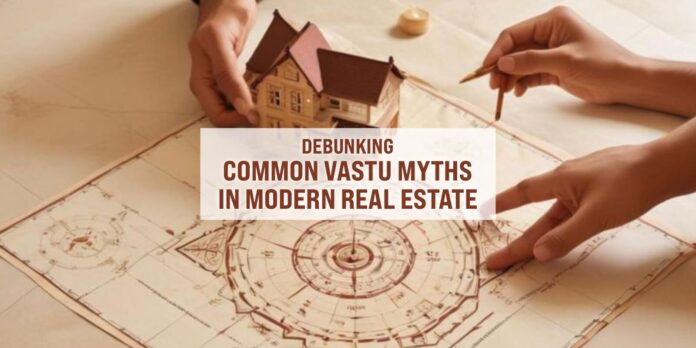Vastu Shastra is an ancient architectural science that has gained widespread popularity in the real estate industry. This age-old spatial discipline focuses on enhancing the flow of positive energy within buildings and promotes overall well-being. However, like many traditional practices, it is also marred by myths that often overshadow its core principles.
In this article, we’ll clear up common misconceptions about Vastu Shastra in real estate and share the facts to guide you in making well-informed design choices for your space.
- Myth: Vastu Shastra is religious and fanatic.
Fact: Vastu Shastra is not a religious belief, although it has roots in ancient Hindu texts and Indian culture. It is a blend of scientific principles, artistic sensibilities, and mathematical calculations. The core of Vastu revolves around optimizing the flow of positive energy, harmony, and balance in a space—regardless of an individual’s religious beliefs. - Myth : Vastu is oblivious to modern architecture.
Fact: Modern architecture and Vastu Shastra can integrate flawlessly with one another. Vastu does not emphasize rigidly following ancient layouts. Instead, it focuses on optimizing energy flow and functionality in contemporary urban homes. Many builders and architects incorporate Vastu principles in designs that align with modern lifestyles. - Myth: Vastu-compliant homes guarantee good health.
Fact: While balance and harmony are at the core of Vastu Shastra, Vastu-compliant homes do not guarantee good health. Factors such as lifestyle, healthy living habits, personal hygiene, and medical care play a far more critical role. Although Vastu promotes well-being and positive energy, it is not a substitute for healthy practices or medical attention. - Myth: All east-facing homes are automatically auspicious.
Fact: While east-facing homes are commonly seen as favorable because they receive the energizing rays of the morning sun, this orientation isn’t universally ideal. The best direction for a property depends on its specific use and the occupant’s personal astrological chart. Homes that afacing other directions can be harmonized to attract positive energy through proper design and adjustments. - Myth: Vastu is only applicable to large homes or commercial spaces.
Fact: Vastu principles apply to spaces of all sizes—from compact apartments to sprawling villas and commercial offices. The science of Vastu emphasizes the importance of energy flow in any given area. Regardless of size, well-applied Vastu principles can enhance both positivity and functionality. - Myth: Non-Vastu-compliant homes bring bad luck.
Fact: A widely believed myth is that non-Vastu-compliant homes bring bad luck or misfortune. While the concept of luck is subjective, attributing success or failure solely to Vastu is misguided. Factors such as hard work, personal decisions, and external circumstances play a more significant role. While Vastu helps create a positive environment, it should not be solely credited—or blamed—for a person’s fortune.
Key Takeaway
Vastu Shastra, as an ancestral science, continues to gain traction in the real estate world. Far from being a superstition, it represents a thoughtful and holistic approach to designing spaces that foster health, happiness, and prosperity. By understanding and applying the core principles—and by dispelling common myths—you can create an environment that works wonders for you and your family.



